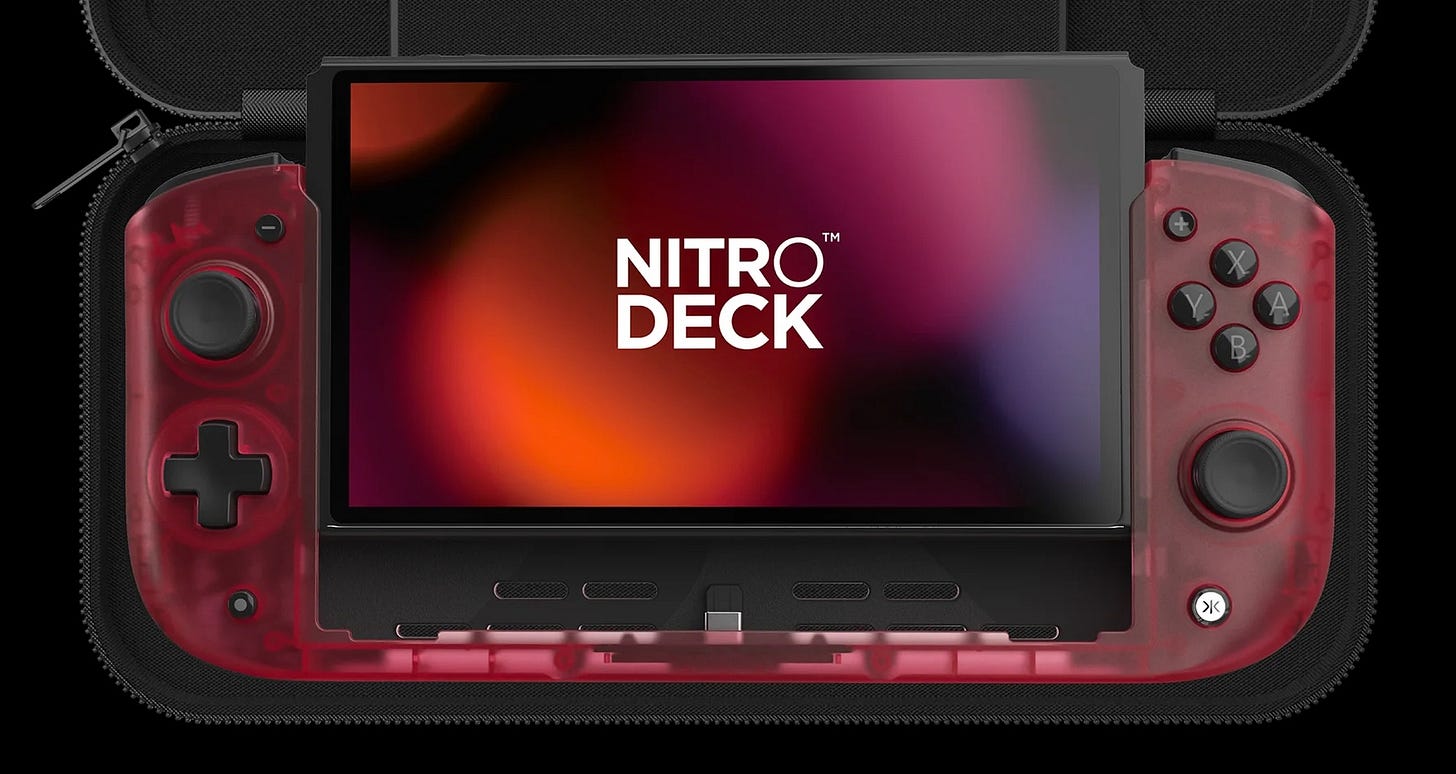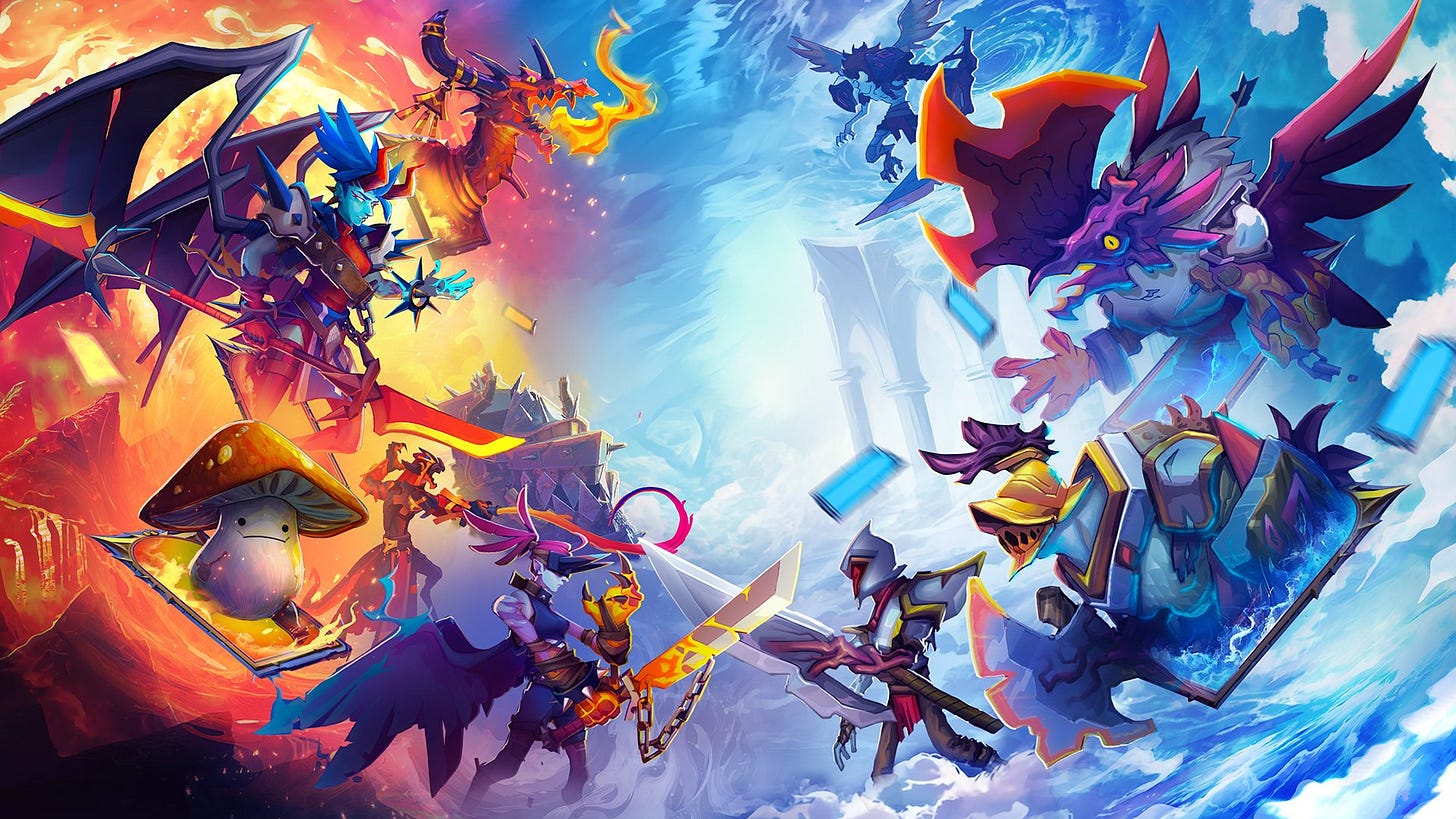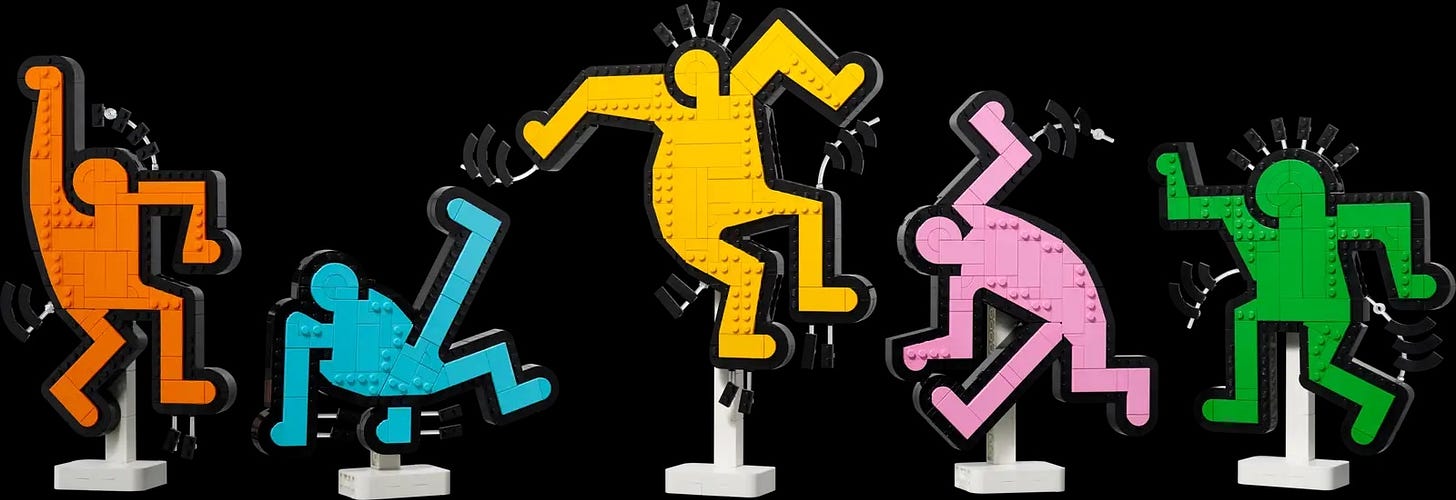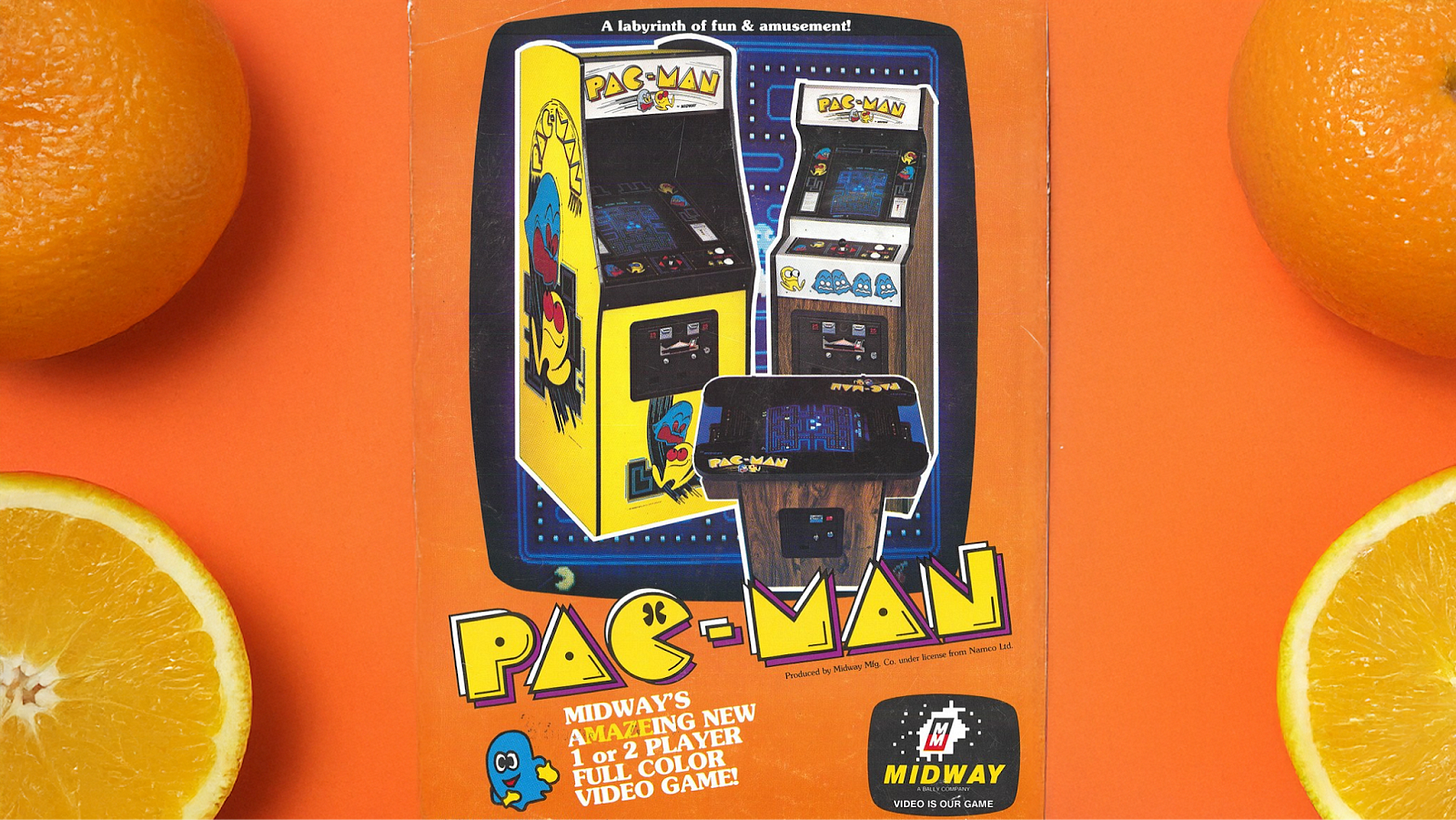Why The Nitro Deck Makes the Switch Better
Plus Xbox Cloud Classics, Lego sanitising the bio of a queer artist, and Tim makes us all feel old
Hello friends!
It’s the week before the Nintendo Switch 2 hits stores, so it’s a bit of a quiet one.
In this issue of Press Any Button, Alice is playing the original Switch more in handheld mode thanks to the CRKD Nitro Deck, and is disappointed that Lego is moving away from “DEI” language. Meanwhile, Tim is playing retro games and making us feel old, as is his way.
Plus, all the games to play this week.
Enjoy!
Finally, the Switch is a proper handful
By Alice
The original Nintendo Switch is a great console, but limited by the fact that holding it for a long time is uncomfortable as hell. It might have been comfortable for people with tiny hands (like children, or presidents) but in my generously proportioned hands it felt like holding something designed by someone who considered aesthetics over ergonomics, so I just didn’t play it in handheld much.
Then, I was given a CRKD Nitro Deck, and it’s changed everything for me. Since I’ve been using the Nitro Deck with the Switch OLED, I have been playing a couple of hours a day very comfortably. The back paddles are so helpful, the extra rumble feels great (though occasionally misfires) and the Hall Effect sensors mean I will never again complain about stick drift while playing in handheld (I reserve the right to complain at other times).
But, most importantly, it’s comfortable. The Nitro Deck takes every complaint I had about the Switch in handheld mode, gives me a hug, and then solves all my problems. Plus it comes with a really nice carrying case. I would go so far as to say it’s an essential for every Switch owner who frequently plays in handheld mode. I hope they release one for the Nintendo Switch 2 soon.
However, it’s not perfect. I’m frustrated that there isn’t a way to thumbstick toppers on, so they don’t come off. I understand that they’re removable for customisation, but one of my thumbsticks has disappeared into the abyss and now I have to work out where replacements are available from. A locking mechanism would be a great addition for the next generation.
That said, given how much more I now play my Switch, and how comfortable it is, I can certainly see past that one minor downside, given all the benefits.
What to play
A trio of free games is up for grabs at the Epic PC store. Deliver at All Costs is a brand new one that looks a lot like an old-school top-down GTA but with modern graphics, wacky physics and fully destructible buildings. Then there’s pixel kaiju battler Gigapocalypse and kung-fu roguelike Sifu.
Nintendo has updated its Switch Online library with four Game Boy games, which I’ll list in chronological order. Sword of Hope is a Kemco RPG that barely has graphics, a blend of Dragon Quest and PC text-based adventure games. Gradius: The Interstellar Assault, also known as Nemesis II, is a good horizontal shooter for Game Boy, which is a major qualification. Kirby's Star Stacker is a cute cash-in on the falling block puzzle craze. And finally Survival Kids is the sole Game Boy Color game of the update, a 1999 survival sim that essentially has all the aspects of the now-popular genre, from hunger meters to crafting, but it’s in the visual style of a Pokemon or Link’s Awakening. And if the name sounds familiar, it’s because a new game in the franchise, also called Survival Kids, is set to be a launch title for the Switch 2.
New on Game Pass this week is incredible deck-building roguelike sequel Monster Train 2, in which the angels and demons now need to join forces to take on a common enemy, as you do. And also Tales of Kenzera: ZAU, an Afro-futurism action platformer that comes by the way of EA Play. Plus, there’s one more unexpected addition …
Cloud Classics
By Tim
Microsoft has added a new app to its Game Pass library for PC and Xbox, called Retro Classics. Now obviously Xbox has only existed since 2001, so you might think it doesn’t have anything especially retro to offer beyond the original Xbox games you can already play on its consoles. But Microsoft also now owns Activision, a company founded in 1979, and that’s where these co-called classics come from.
A huge number of the 60 games included here were originally published for the Atari 2600 and can be hard to go back to, while there are also a small number of options from the Amiga, SNES or later. But at the moment I’m a bit less interested in the games themselves and more intrigued by the delivery method. Microsoft has talked a big game on preservation, so we could be looking at the plan for allowing current players to enjoy ancient back catalogue delights going forward. But to be honest it’s currently less than ideal.
The obvious way to do this would be to package a bunch of licensed or open source emulators into a wrapper, which is essentially how classic games work on PlayStation and Switch. I guess an issue there is that the apps will swell in size as you add more games (and I expect that to be a problem with the Gamecube app on Switch 2), but for earlier 2D games this is less of an issue. Instead, what Microsoft has done is partnered with Antstream, to give Game Pass subscribers access to its lineup of Activision games without having to pay an Antstream subscription.
The result is a pretty messy interface for an official Xbox product, and some strange ad-links for the full Antstream service littered around the place. But the real issue is that streaming is just a clearly inferior way to play retro games compared to local emulation.
Antstream is pretty good at the tech by now, and control is not the problem. I played a bunch of 2600 games and there was no discernable lag; they play great. But there are visible compression artefacts, and flickering around certain graphical elements. I booted up Mech Warrior 2, which is a PS1 game, and it was unplayable. Full-screen flickering made it impossible to look at, let alone operate.
Offloading the whole stack to a developer that’s already offering these games has obvious advantages. Games load up in around 10 seconds flat, you get multiple save slots for each one, things like achievements and challenges are already built in, and it shouldn’t be difficult to add more games to the service. Since Microsoft also owns Rare, Blizzard, Double Fine and more, the lineup could become seriously great.
But none of that matters if players can’t be sure the games will run in an acceptable state.
Bricks, Boards and Beginnings
by Alice
Lego has just launched the new Keith Haring Art Set, and it’s a potentially brilliant way to honour this iconic pop artist. It’s impossible to separate his work from his queer rights activism, particularly how he used his art to advocate for safe sex in the 1980s, before he died in 1990. His work Unfinished Painting is such a moving piece, representing his life being cut short by AIDS.
Well, I should say it’s almost impossible to present his work as separate to his activism, because Lego has done exactly that. As part of Lego’s move away from DEI and towards more “neutral” language in relation to LGBTQIA+ topics, the Lego artist’s bio about Haring doesn’t mention anything about his personal life, motivations, or influences, just that he did “subway art”.
This is disappointing on multiple levels. It’s a capitulation to Trump, yes, which is upsetting, but it’s also stripping the Lego Art range of its meaning. This kind of art can’t be separated from the artist without it losing its soul.
I applaud Haring’s estate for following his wishes to licence his work out for commercial use and give the money to charities, so there is good coming from this, at least.
But I’m so disappointed to see Lego so easily abandoning a community that it was fine to sell to when it was popular. It’s not like it’s a publicly traded company that has shareholders to answer to. This is a stand the company could make if it wanted to.
The product roadmap takes so long, that we won’t see the true ramifications of this step back from acknowledging diversity for a few years. But I hope that Lego is just adjusting its language to get past tariffs, and continues supporting and celebrating all children (and adult fans of Lego) and their families in the ways it can get away with. Pretending we live in a world devoid of diversity sounds boring and sad.
Retro Esoterica
by Tim
As May comes to an end, here are some games that have celebrated a major anniversary in the past 30 days:
Now 25: Perfect Dark As a followup to the iconic GoldenEye, Perfect Dark was both an impressive improvement across the board and a radical departure in subject matter and scope. From the full voice acting (which was pretty unusual on the Nintendo 64) to the graphical effects, and from the outrageous guns to the extraterrestrial invasion storyline, everything about the game was an absolute swing for the fences and it connected more often than not. The Xbox port remains a wonderful split-screen experience.
Now 40: Gradius This scrolling shooter is so full or arcade innovations that it can feel oddly generic when played today. At the time though, collecting floating pickups left by enemies that you could then activate to install upgrades or switch weapons was a marvel, as was defeating massive bosses by sapping away their defenses and blowing up a central core. Gradius remains a tough but fun play, and a new collection coming in August promises various versions of this original and six other arcade games in the series.
Now 45: Pac-man It doesn’t get much more iconic than this. Namco’s Pac-man was an unprecedented mainstream hit in the arcades, even though by all accounts the hardcore gamers of 1980 didn’t think very much of it. Unlike Galaxian, Space Invaders and Asteroids, Pac-man was adorable and actively welcoming to new players. Getting cornered by a ghost feels fundamentally different to being smashed by an indifferent alien craft, which I think likely kept people playing, and the hardcore eventually discovered there’s a lot more to the design than meets the eye.








Going from ‘Cool Haring LEGO set!’ to frowning disappointment over LEGO’s policy change gave me whiplash